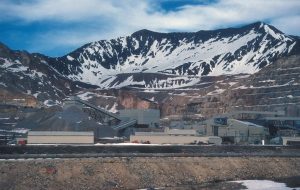When most people think of Colorado mining, they think of gold or silver, or maybe coal. But one of Colorado’s most significant mineral resources of the past century is molybdenum. Today, however, demand for “moly” is declining. Plans were recently announced to shutter Clear Creek County’s huge Henderson Mine — the world’s largest primary producer of moly, according to their website. The Henderson underground mine is owned by the same company that owns the Climax Mine, an open-pit moly mine. Over the past century, demand for moly has fluctuated, with the Climax Mine closing and reopening several times.
What is molybdenum, and how is it used? Moly, for short, is used as an alloy in steel production. Its usefulness as an alloy is due to it having a higher melting point than iron. The Climax Mine began production in 1914. After the U.S. entered the war in 1917, demand for moly rose sharply due to its use in the production of war matériel; however, at the end of the war, the mine shut down when demand was reduced. It reopened in 1924, shut down in 1995, and reopened in 2012. During its heyday during mid-century, Climax had been its own town, with schools, housing, a post office, and a railroad station. Most of the houses were moved to nearby Leadville in 1965.

This report includes analysis of the history, use, and chemical properties of moly along with a review of moly deposits across the state. Moly deposits in countries such as Australia, Canada, Germany, and Norway are also examined, as is an analysis of the predicted future of the industry. Because the report had been commissioned during the war but was not produced until 1919, after its completion (and the same year the Climax Mine closed the first time), the report had begun with optimism for the industry but ended on a much different note. “From what has been said in the preceding pages it is evident that, at the present time, the outlook for a rapidly expanding industry is none too bright…It is the writer’s belief that the demand will increase slowly as successful metallurgical experiments develop new uses or improved uses for the metal,” wrote Worcester.
Want to learn more about moly? In 2001, the Colorado Geological Survey produced an entry in their “Rock Talk” series entitled Unsinkable Moly: Colorado’s World-Class Metal Resource. This pamphlet describes in plain language the uses, geology, and history of moly in Colorado as well as its two major moly mines. For more on Colorado’s geology and mining history, search our library’s online catalog and digital repository.
- How to Spot the Differences Between Eagles and Hawks - August 16, 2021
- How Transportation Projects Help Tell the Story of Colorado’s Past - August 9, 2021
- Time Machine Tuesday: The Night the Castlewood Canyon Dam Gave Way - August 3, 2021